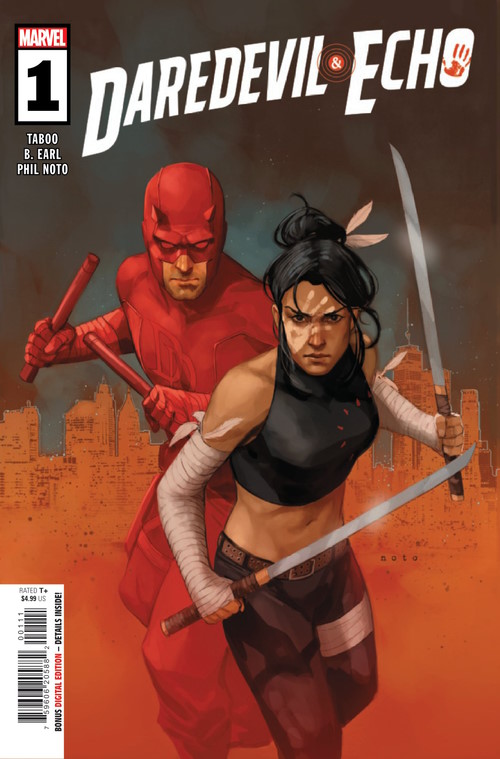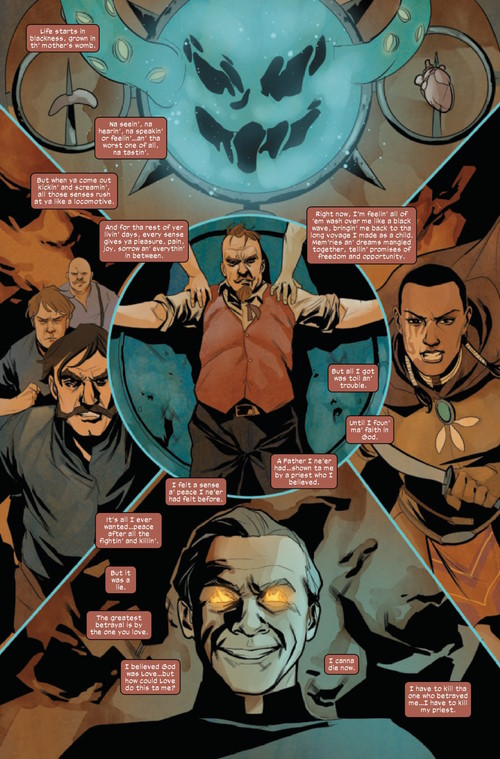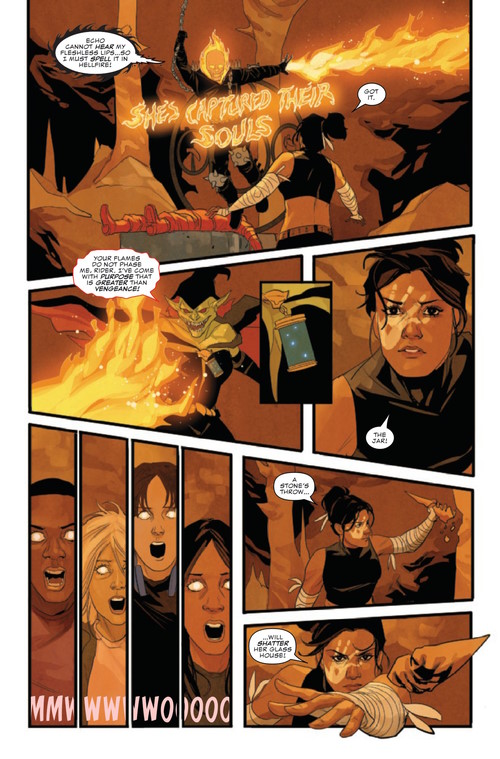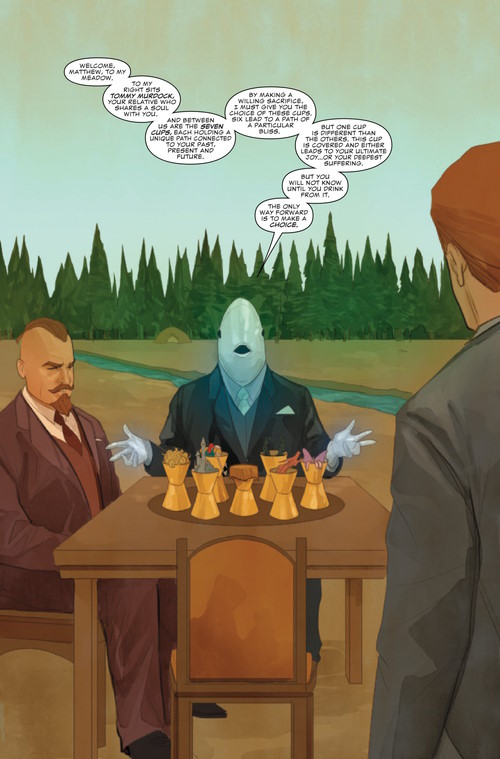The co-writer of DAREDEVIL & ECHO talks about collaborating with Taboo and Phil Noto. Many thanks to him for discussing the many ideas and concepts that influenced the plot, characters and more in the mini series.
This interview was conducted September 15, 2023.

Kuljit Mithra: Thank you for taking the time to talk about the DAREDEVIL & ECHO series you co-wrote with Taboo. I bought all four issues, but I had wanted to read them all at once. I feel that the monthly gap makes you forget what's going on. I think it reads better together... just for what both you and Taboo were trying to do with this.
B. Earl: You know, it's funny because all the projects that we've been given, it's like I always feel like we're like a Special Ops team, we get parachuted in. It's very much like [Editor-in-chief] CB [Cebulski] or [Executive editor] Nick [Lowe] or in this case with Daredevil was [Editor] Devin Lewis. He reached out and said, hey, you know, we were working on DEADLY NEIGHBORHOOD SPIDER-MAN at the time... and he said, hey, I got your next assignment. Are you guys are willing to accept it. And it was like, okay, what is it? He said it was Daredevil and Echo and it was a pretty cool opportunity.
You know to your point it's like these are written like movies. They're written to be sort of read as one and that has been the challenge. I think it's one of those things when it comes to, you know, anything being read by critics. If they're reading it as one issue, you know, issue 2 got hated on by some people because they felt like, oh, it's too much flashback. But then when you got to issue 3 and 4, you realize no, it wasn't flashback.
Mithra: Right, it wasn't really flashback, it was happening at the same time.
Earl: Right, but if you also paid attention it was the realization as they walked up the stairs.
Mithra: Yes.
Earl: It was cut back and forth. So, it's again you have an entire month you're not gonna remember. Anyway those are the challenges in writing a monthly that's read to be a trade.
Mithra: Yeah, you're not gonna remember. So when Devin Lewis comes to you and says he wants you to write a Daredevil mini, is he giving you an idea of what he thinks it should be about? Like this kind of story is not the typical Daredevil story.
Earl: So, Devin came and said, hey, you know, what we're doing is a Daredevil and Echo team up. And you can do whatever you want with Elektra. She's in there. She's Daredevil now as well. So if you have some ideas, do what you want to do with her.
We wanted to create a new monster and we wanted it to be more horror because that's kind of what Tab and my love of, you know, 90's horror, 80's horror, so that was sort of the parameters.
And for me as a writer, I'm very much about esoteric and spiritual things and for writing this I felt very much connected to Matt in some ways to his Catholic side, so I really wanted to explore this Catholicism.
With relation to, you know, Tab's Native heritage, Echo's Native heritage and looking at how can we lens it in a way where it's not so on the nose... we're talking about children being taken from their families right so that's the metaphor of the children being taken by the Demagoblin. I wanted to layer these things in without being on the nose of, you know... we're talking about these heavy issues... like when Christianity came in and absconded with the Natives' land and culture and everything and push that through. So that was something I wanted to explore in our story.But one of the big things, you know, and it's one of my little Easter eggs I often do in these little Instagram posts. I mean, I've been reading Tarot cards since I was 11 and that world of the Fool's Journey.
Mithra: [The Fool's Journey is a metaphor for the journey through life, a journey of self-discovery, growth, and transformation].
Earl: And the symbolism of it has really been a big part of my own journey. And especially more recently.
Oftentimes, you know, I want to make it a growth quest. It's me being creative in my lab and weaving some things up and going alright, what do you think of this? So the original pitch to Devin was what if we would make Hell underneath Hell's Kitchen. But it's not the typical Hell we have.
And then I said, I love Gangs Of New York. And I love From Hell. And what if we match all these together and then sprinkle some Children of the Damned children into it.
Mithra: Right, I see all of that now.

Earl: Our initial pitch was supposed to be five issues but we got one cut after finishing the first issue.
It wasn't going to all take place under the church, but when you have 20 pages cut you're kind of like yeah, pacing is gonna kill a reader if we try to do something a little more.
Mithra: When you're working with Taboo, are you both writing and then melding it together or is one doing a plot and one is doing the writing?
Earl: I'm being completely transparent, I mean, I'm a writer. I've been doing it my entire life in my career, but I'm also a filmmaker. Like I make films, I'm a director, I'm an editor. So I'm like the kind of in the trenches kind of creative. Tab obviously comes very much from the in the trenches of the music side and you know obviously a lot of his influence and references are coming from what he loves in pop culture as well as his relationships and connections to being First Nations as well as being Mexican and the indigenous side of Mesoamerica. But when it comes to writing, I mean, I write. I throw the plot, but I'll ping it off Tab. If it's not cool, then I'm gonna change it. Like if we're not both loving it, if it's not dope, then I go back in the lab, if it doesn't make sense, you know, if it's not feeling like genuine or authentic to the characters, like creating Creeping Death. I was like, Tab, what should we name her? You know, I mean, I got this name from Metallica, because I freaking love Ride The Lightning and Creeping Death is obviously a reference to Passover, right?
Mithra: [From Wikipedia, the song is written from the perspective of the Angel of Death, "Creeping Death" describes the tenth plague of Egypt]
Earl: So that was my little nod. My Judaism. So I mean, I'm always layering and all these like crazy little Easter eggs and Tab, you know, is kind of my sounding board when we're bouncing back and forth. But when it comes to the actual, you know, physical part of it, typing it, coming up with a plot, coming up with the story, writing the script, I mean that's what I've been doing my entire career in Hollywood I mean, it's a very supportive system. We support each other's strengths and weaknesses. I mean, as creators, sometimes you're your own worst enemy. Where when you feel like you're creating in a bubble and you don't know, is this working or not working, you know, when you have someone you trust and implicitly have that connection with. It's a different kind of writing process.
Mithra: So when you're writing for a comic, are you still writing it like it is a screenplay? Are you saying this is your setting, this is the narrator, this is the character? Are you setting like a movie shot, like a panel for the artist? Like when you were working with Phil Noto on this, did you just give him the script and he just went off and drew it, or was there more of a collaboration there?
Earl: Well, it's funny because every artist we worked with has been very different. [DEADLY NEIGHBORHOOD SPIDER-MAN artist] Juan Ferreyra is very different than Phil. Both very collaborative, both very creative. But with Phil, you know, the way I like to picture and write, I mean, I do think of things in shots, you know, and looking at it from like a filmmaking editorial standpoint. I think of it as like, all right. These are the assets, right? We have a wide shot. Well, I can start going close up. This is our pacing, this is what happens in 1 through 4 and you know, generally looking at, you know, what has to happen in each shot. And Phil actually was pretty much spot on in this script with what he came back in with was very much like what was described.
There was a few times where we, you know, had to kind of go back and forth where I made mistakes in the script. There was a time where I think it was in issue 3, there was like a cutaway and then we cut back to the old time period and then we cut back to the other time period when Echo was falling. So it was like she was falling and then we cut back to the other time period and Phil delivered that and it was like we both went back and forth. Like you know what that's wrong pacing, let's change it up because it feels like the fall should finish it's not like a cliffhanger. It sounded better on paper. You know, it just made more sense on the paper, but when we saw it visually, so it wasn't like a major change or anything.
But yeah, there's some really great things. He was the one who came back and said, hey, you can't really read Ghost Rider's lips.
Mithra: Yeah!

Earl: And, and it was like, oh man, you know, you're right. And that was really the biggest challenge, right? You have so little space to tell this story and you have to have moments where there needs to be some sort of exposition if it has to come to dialogue. So, hey, why don't we just have him write fire in the air. This was suggested by our editor Annalise Bissa. She is brilliant. I was like, oh my goodness, thank you. Phil, you figured it out. I mean writing comics obviously is a very different medium than filmmaking because you're always changing the frame size. In a film you have a 16 by 9 or 2.3 5 or whatever it is and that's all. The thing I love about comics is we have an opportunity to really, you know, sort of break things. And shift how they can temporarily be experienced. So I mean that to me is like filmmaking from an editorial standpoint really is much like how fast we cut between shots, how many panels we have on a page, you know, and kind of how quickly you're moving through a panel versus how long you're going to stay on it. So I think that's a lot of the fun of looking at the two styles.
Mithra: I wanted to learn more about when you came up with the idea of writing these ancestors of the two main characters. So we have Tommy Murdock, you know, who is... What would he be Matt's great-great-grandfather?
Earl: It turns out it's I think four greats if he was born in like 1800 or even 1795 right like because it's taking place around 1835. It's the beginnings of the Dead Rabbits, so let's have Daredevil's ancestor be a founding member of the Dead Rabbits.
Mithra: Okay. Yeah.
Earl: I thought that would be a really cool, sort of, canon thing to weave in with this story.
Mithra: Did you think Marvel would have said, no, you can't do something like that just because it changes the history of Matt Murdock?
Earl: Well, you know, it's funny, cause that was the whole pitch of Gangs Of New York. Let's tell a time travel story without traveling through time. Right? Let's show characters from the past. And if you look at the body of work Taboo and I have done at Marvel, you know, a lot of it relates back to Tab in particular and how much he relates to always talking about his grandmother and how that this is something so influential on him as a young kid coming up and this sort of ancestral journey. Even with [Ghost Rider] Kushala, there's a whole ancestral journey in the Infinity series that we did and even in the one-shot. So this is sort of an extension of that an ancestral journey but in a different sort of way where you're bringing these two ancestors and ultimately saying, okay, let's really try to do something different by showing how these ancestors are forgiving the sins of that past by completing that circle. And yeah, when we pitched that, I mean, they were they were really excited about it and they love the characters that we created. And Phil, I mean, just such an incredible job. I mean, he nailed it.
Mithra: Yeah, he's an amazing artist. His work is just always the best.
Earl: Yeah, he's amazing. Hats off to Phil. He's such a great guy. He's such a sweet person. Good heart.
Mithra: Awesome. I did have a question about some confusion I had at the end of the story.
Earl: Hmm. Okay.
Mithra: So the egg that Matt takes to Creeping Death, is the Golden Heart based on anything? Wanted to learn more about that.
Earl: Yes, but it's not anything in the Marvel Universe. It's actually from Carl Jung's The Red Book. There's an entire sequence in a dream sequence that he talks about. There is kind of an ancient mythical God, you know, dark God. The only way that he could cross the hearth was by putting him into a golden egg and trapping him in this golden egg. He was able to cross the hearth into the homestead basically. I'm kind of butchering it a little bit.
The thing that really resonated with me was like this mythical journey that we have in dreams and again connecting back to the Grail quest, connecting back to the 7 Cups and that illusion that basically the salmon gives him, which is the Blind One, you know, which is his Catholicism because salmons are connected to Celtic myths as well as the the Catholic side of things in Christianity. So you've got this sort of arc that goes from Grail Quest and dreams. And ultimately, he is taking that heart and connecting it. It's the egg, this sort of male-female energy. And connecting them back together again in the universe. So that was the ending, this concept of these great cycles, everything being cyclical. And this is pulling not only for native mythology, but from a lot of, sort of, world mythologies of these great cycles. And ultimately what it was that he was setting off in his cycle. And it was an inhale and an exhale. So the ending is that he's putting the egg back in. And it turns into the inhale. So we've been in this big day. And now everything's going to start coming back together again. And Matt sets it in motion. So who knows if anyone will ever do anything with that concept. That would be cool. I just wanted to put a little something for everyone coming after where they could reference when Matt put the egg in the heart of the universe.
Mithra: Wow, I guess I should go look that up.
Earl: I like audiences to read at one level, but then if you start catching the little threads there are so many things that once you start pulling on threads, there's gonna be rabbit holes that you're gonna go down and go, oh wow. There's more to all of this than, you know, and it's kind of culminating in a body of work is kind of how I'm looking at what we've been doing at Marvel and even in my own life as a creative and producer and I also work in tech as well.

Mithra: I was gonna ask about the 7 Cups, but you've touched on it.
Earl: So yeah, the Seven of Cups is a card in the Tarot deck. Basically the card itself means illusion. Right, it's that you don't always know what the right choices are. And it's that fact that often you can get misdirected into what is real, what is not. So it goes back to like cups and in Tarot very much connected to the emotions and the subconscious and dreams, right? So that's where Matt is and that's why he has to take the cup, which is like Indiana Jones, you know, when he has to find the grail, right? It's like, it's the wooden one. It's the one that you least expect. Well, it's the one that's covered, right? So he has to have blind faith. He has to take the cup, right? So that was kind of weaving in that Tarot into the Catholicism concept of, you know, blind faith, belief in God, and you will be saved kind of thing. And ultimately, it sort of goes in the trajectory of what Matt believes in, but it also opens his eyes to that there's a lot more out there than just, you know, what he's learned so far as a Catholic.
Mithra: Another question I had, was when Matt lets Echo stab him... does he know that Tommy is stuck there with the Blind One? And was Tommy stuck there because he didn't sacrifice himself? He used that rock to kill Father Emmett.
Earl: Yeah, but also by breaking this stone, the altar, by breaking the altar, he broke the connection between the other side and this side. So the altar itself, cause it had the blood, it was the sacrificial altar. Once it broke, basically that conduit for the Blind One coming through, it sort of broke the communication. It was like, you know, breaking a short wave radio, breaking out the antenna. Like it was pushing through it wasn't able to get through yet but Creeping Death was like I'm gonna go through but you need to break that. So it's like seal the gate but he broke it and ultimately he goes no, no, no, no, and it pulls and it takes him. She was just hoping that he would die on the other side. Right, but the Blind One and it's like final moment, you know, he's like, no, don't do it, that last shot and then it's like we don't see him get pulled in.
It's just that assumption, you know, by him saying no, don't do it. But I think when you talk about Matt, basically Matt had to just kind of go on that blind faith. He didn't know anything about Tommy other than Tommy was involved with this, you know, and the fact of Creeping Death told him that Tommy wasn't able to make the willing sacrifice and that was the cause. So it's like this whole thing of, you know, the fact that he's not able to give in to that. Matt has to basically just trust Creeping Death knows what she's talking about and that Echo is as much you know a conduit to Creeping Death and that he has to have that faith. And so I think, you know, when you talk about Tommy, did he know that Tommy was there? I think that he probably had some sort of feeling that maybe Tommy was. I mean, obviously he knew Tommy was associated with everything, through the church when he has that.
But, but I don't think he knows he's going to meet his ancestor, you know, I don't think that was, he's just like I have no idea what's going to happen.
I'm just having that blind faith which then continues on in his choice with the cup.
Mithra: Everything's making more sense, so I hope Daredevil fans read this interview and get a better understanding. I think this will add an extra level.
Earl: I know. Well, thank you. You know, it's challenging because you want to write stuff that has meaning, right?
You want to write stuff that has depth and has gravity and you know but also the same time operates to the level where it can just be read.
Mithra: I'm very appreciative of your time that you were able to answer all these questions. This was great. I appreciate it.
Earl: I mean, look, I could talk for hours about this. I'm really, you know, I'm so passionate about our storytelling.
The things that we're doing and what we have done, and you know, it was such an honor to write Daredevil. He's such an incredible character and you know to be able to do something just a little bit different with him and it was challenging to write with Echo you know and having Ghost Rider in there too. I mean, there was a lot of stuff happening in the story and the kids. I mean, I love the kids. The one kid is actually my son. That's my son.
Mithra: Oh, Leor, is your son? Okay.
Earl: Yeah, he's a metal head. You know, actually it's all of our kids... like so Phil's son is in there and Taboo's daughter is in there and then there was one random. So the four children of the apocalypse are our kids!
Mithra: Ha, cool! Alright, once again, thank you very much.
Earl: Absolutely, take care.
Mithra: Okay, take care. Thank you. Bye.
--------------------------------------------------------------------------------------------
(c) 2023 Kuljit Mithra & B. Earl
Daredevil: The Man Without Fear
https://www.manwithoutfear.com
--------------------------------------------------------------------------------------------














Daredevil (and other related characters appearing) and the
distinctive likenesses are Trademarks of Marvel Characters, Inc. and are
used WITHOUT permission.
Copyright © 2024 Marvel Characters, Inc.
All
Rights Reserved. Visit Marvel.com.
www.manwithoutfear.com is owned and operated by Kuljit Mithra.
Web site is © Kuljit Mithra 1996-2025.
Keep up to the date with your trusted Daredevil source ManWithoutFear.com on  and
and 